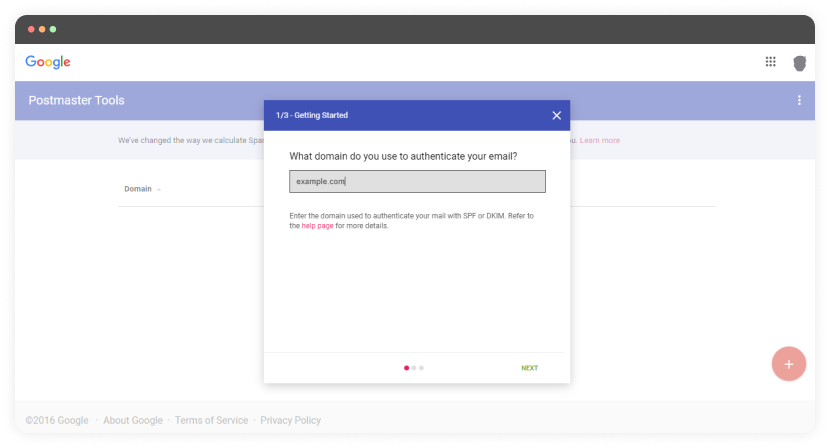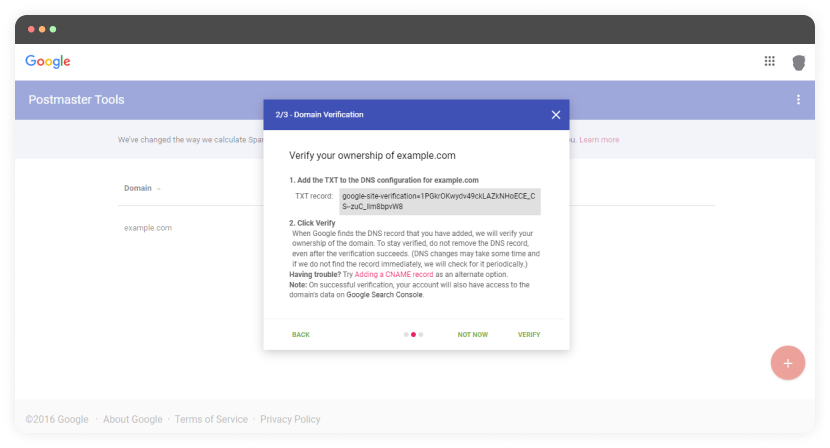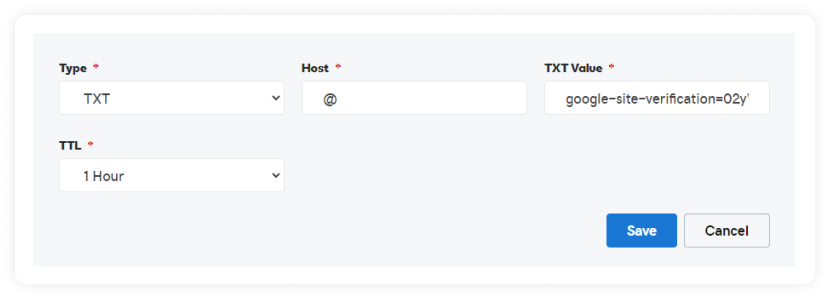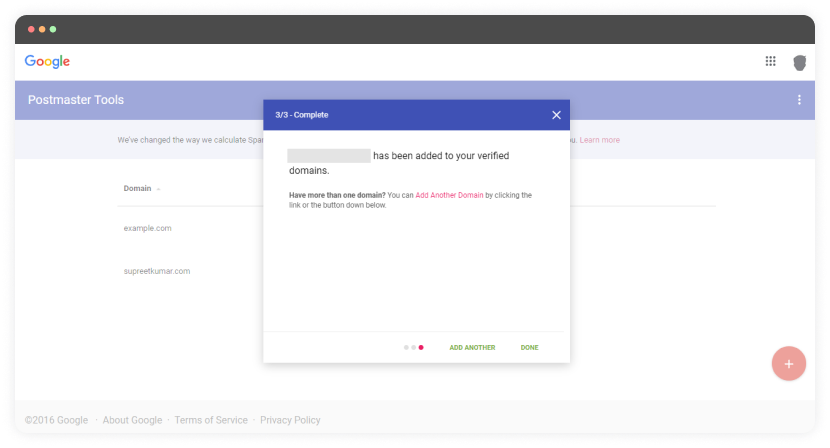“You cannot change what you don’t manage; you cannot manage what you don’t track.” – Valentino Crawford
If you want to improve the ROI of your email marketing, you’ve to track, measure, and refine your email campaigns.
But it can be hard. Not getting accurate data and juggling between multiple tools to check different criteria makes the tracking process annoying.
But fortunately, you can use Google Postmaster to measure various criteria such as domain reputation, IP reputation, and spam rate in a single tool.
Let's learn what Google Postmaster is and how you can use it to improve your email performance.
Table of contents
- What is Google Postmaster?
- Why should you use Google Postmaster?
- How to set up Google Postmaster?
- 6 beneficial tools that Google Postmaster offers
- Wrap up
What is Google Postmaster?
The Google Postmaster is a performance measurement tool that tracks and analyzes email campaigns of Gmail users. It provides the performance data only against Gmail users. The factors you can measure are:
Domain reputation
IP reputation
Delivery errors
Spam rate
Authenticated traffic
Encryption
We will discuss these factors in detail later in the guide but first, let’s discuss the benefits of using Google Postmaster.
Why should you use Google Postmaster?
Gmail is the email client of choice for a good portion of email users for several reasons:
With a market share of 27.4%, Gmail held its ground as one of the most popular email clients.
If you regularly send emails to your email list, most of them probably are Gmail users. So, Gmail is already familiar with your sending IP address and domain name.
Since Google owns Gmail and Postmaster, it can take the performance data from Gmail and provide that in the Google Postmaster. So you’re getting accurate data straight from one of the largest inbox providers in the world.
Google Postmaster also helps you track many different criteria all in one place. This eliminates the need to juggle multiple apps making the tracking process easier.
But before you do any tracking, you’ve to set up your domain and verify the details. Then only Google can know which domain you own and provide you with the right data. Let’s learn how to add your domain to Google Postmaster.
How to set up Google Postmaster?
Follow these steps to set up your domain on the Google Postmaster:
Visit the postmaster.google.com and log in with your Gmail account.
Click the “+” icon at the bottom right of the screen.
Enter your authentication domain name in the popup that appears next.

- Google Postmaster will generate a TXT record. Copy it and add it to your DNS configuration of the entered domain.

You can add a CNAME record as an alternate option if you’re having trouble with the TXT record.
The below image shows how you can add your record to a GoDaddy domain name. It will be similar for other domain name providers as well.

- You’ve to verify the ownership after you’re done adding the record. You can do this by clicking “Verify” in the popup, which will show you a success message.

- Once you’re done adding and verifying the domain, wait for some time until Postmaster collects your associated data. Once it’s done with that, you can explore the tools it offers and measure your email campaigns.
Let’s learn what it offers and how it can benefit you.
6 beneficial tools that Google Postmaster offers
Here we will discuss 6 vital Google Postmaster tools that can help you track and analyze your email marketing performance:
1. Domain reputation
Domain reputation is how inbox providers see your domain name. If the emails you sent from have received significant spam complaints, your domain reputation will be poor. Instead, your reputation will be good if you send helpful emails with great open rates from your domain.
Google Postmaster will rate your domain reputation as bad, low, medium, or high. If it is nearer to the bad spectrum, you should work hard to improve it. If it is nearer to the high spectrum, you should work hard to maintain it. Either way, this feature gives you a score to measure and improve your reputation.
2. IP reputation
Your emails are sent from a device with a particular IP attached. If many spam emails are being sent from that IP, the inbox providers will assign a negative reputation to it. On the other hand, if it is a dedicated IP address and well-maintained, it will earn a good reputation from inbox providers.
Again, the Google Postmaster will rate your IP’s reputation as bad, low, medium, or high. If it is on the lower end of the spectrum, improve it. If it is on the higher end, maintain it.
3. Spam rate
Spam rate helps you identify the percentage of users marking you spam. These people may not have found your content helpful. So if this number is significantly high, you'll have to make some tweaks to your email campaigns. Here are some suggestions:
Find the right email cadence and follow it.
Form a sunset policy and identify disengaged users.
Create a suppression list and cut your ties with these users.
You’ll see a positive change in your spam rates if you follow these three steps.
4. Delivery errors
Not every message reaches your user’s inbox, and there can be many reasons for that. The delivery error dashboard shows you the percentage of emails that didn’t make it to the users’ inboxes and got rejected – temporarily or permanently. Follow these steps to lower this rate as much as possible:
5. Authenticated traffic
In this dashboard, you’ll be able to see how many emails have passed the DMARC, DKIM, and SPF records versus the total number of emails that attempted to pass. This dashboard has three graphs meant to show the data of these three records.
SPF graph: This graph shows the percentage of emails that passed SPF vs. all emails from that domain that attempted SPF, excluding any spoofed emails.
DKIM graph: This graph shows the percentage of emails that passed DKIM vs. all emails from that domain that attempted DKIM.
DMARC graph: This graph shows the percentage of emails that passed DMARC vs. all emails received from the domain that passed SPF or DKIM.
6. Encryption
Emails must be encrypted to keep your data safe from third-party intruders. And for that reason, this graph shows you the number of incoming and outgoing emails that were encrypted. The Transport Layer Security (TLS) mechanism is used to check the encryption of emails.
The encryption graph should always be at 100%, and if it isn’t, it can become a serious security and deliverability threat, and you need to get it sorted quickly.
That’s it. Congratulations on making it this far!
Wrap up
The Google Postmaster is an amazing tool you can use to increase your email campaign performance. If you use this tool correctly and improve weak areas, you can pump up your conversion rates by a significant number. Generate more revenue than you would have ever anticipated!
What you should do next
Hey there, thanks for reading till the end. Here are 3 ways we can help you grow your business:
Talk to an email expert. Need someone to take your email marketing to the next level? Mailmodo’s experts are here for you. Schedule a 30-minute email consultation. Don’t worry, it’s on the house. Book a meet here.
Send emails that bring higher conversions. Mailmodo is an ESP that helps you to create and send app-like interactive emails with forms, carts, calendars, games, and other widgets for higher conversions. Sign up now and send 10k free emails/month. Sign up here.
Get smarter with our email resources. Explore all our knowledge base here and learn about email marketing, marketing strategies, best practices, growth hacks, case studies, templates, and more. Access guides here.

